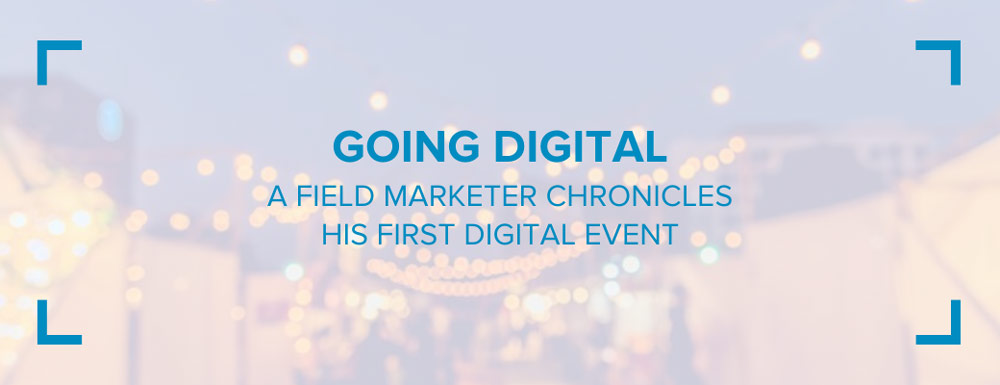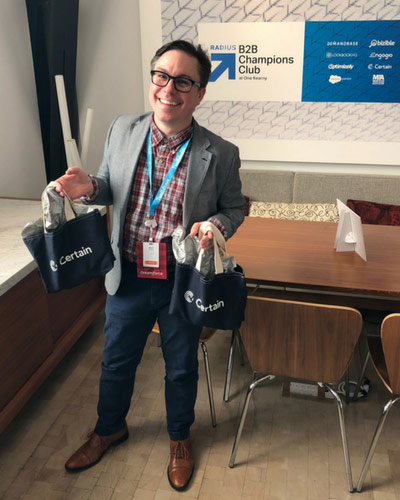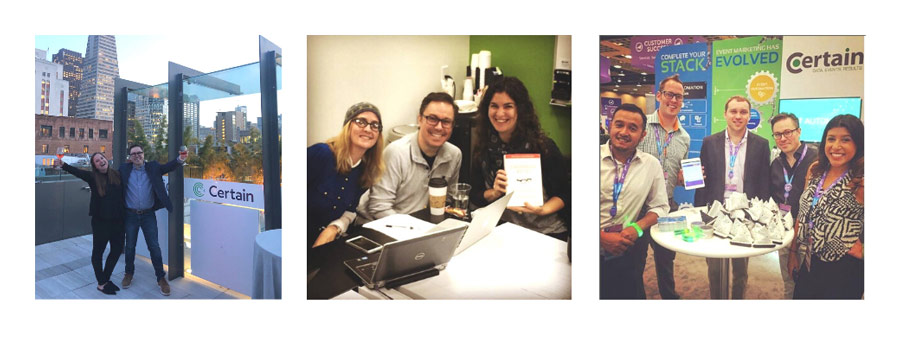I don’t need to recap recent headlines to underscore that this is a scary and confusing time for everyone, but for in-person event marketing professionals and freelancers, you might say that this is a ‘dark night of the soul.’ Some have seen reductions in their paid hours, and some are out of work altogether.
That hardship doesn’t go unacknowledged, and my hope is that everyone with a stake in the event industry is finding the support they need to get through this time. Some event marketers are working quickly to adapt their event strategies to all-digital formats for the remainder of 2020. That’s the camp I happen to fall in.
Finding Solid Ground by Channeling Moira Rose
Like many of my colleagues, I was ramping up for a rigorous in-person event slate alongside my marketing and sales teams before this colossal Force Majeure hit the pause button on everything. It’s difficult to get a grip on how long this quarantine will last. “All we can wish for our families, for those we love,” to quote Moira Rose in the wonderful finale of TV’s Schitt’s Creek, “is that the wind will eventually place us on solid ground.”
I’d like to include all my fellow event professionals in that sentiment. But instead of landing in a small town with a particularly cringeworthy name, we are muddling through a time when in-person gatherings (literally the basis of our job) are off the table.
Scanning daily economic news headlines these last few weeks can make any project manager’s inner weathervane spin. What we do know is that, barring any happy surprises, social distancing could last as long as eighteen months until we have a vaccine widely available. That means those of us professionally charged with getting people together will only be doing so virtually in the near future. (BTW, I’m learning the advantages and disadvantages of both formats and that will be the focus of a future post).
Full disclosure, I’ve never managed an all-digital event. My intention for this blog is to record my own experience in the process of managing my first one. Hopefully it will offer some assistance to others that may be approaching this format for the first time. I do believe that crisis is often a catalyst for growth (as a proud Gen Xer, I’ve survived my share of marketplace crisis) and the skills, and workflows that we event marketers already possess are entirely transferable.
Above all, events are eternal. And like the content we consume every day, the need for getting together with other people won’t go away. It’s just the technologies and formats that change. So this is a chance for all of us to grow and bring new elements into our roles, and potentially shake up our field marketing tactics. With technology, event marketers can thrive any direction the wind blows. That’s how we’ll find that solid ground, professionally speaking.
Takeaway: Events are eternal. So I guess I can stop pettifogging and realize this can be a heuristic experience

I’d Like to Phone a Friend!
Fortunately, I can review my strategy with my colleagues at Certain – a collaborative culture (thankfully), and our teams are already in the trenches (digitally) with customers. Certain has long created digital solutions for events, and it’s been gratifying to see how quickly our leadership, customer success and dev teams have been able to support our customers during their event strategy transitions for 2020.
In a few weeks, Certain will even launch new products that are built for enterprise-scale digital events. It will include strong integrations with major video streaming platforms and combine them with Certain’s robust and secure event data superpowers. Working with our customers and putting digital event features on the fast track is helping to ease the transition of their events going digital (see Rockwell and National Instruments).
As for my efforts, obviously one major component that I already have at my disposal is Certain’s event tech. Huzzah!
Marketing departments (usually) are an amazing mix of people with creative, organizational and sales oriented backgrounds. You could argue that the best event marketers will have developed all of those muscles. Each will have a particular strength on the spectrum, and that’s what makes us unique. I have a number of colleagues working successfully in the industry that are reflective of that. So I decided to reach out to a few friends for advice, and what they are expecting in the coming months before embarking on this adventure.
My friend Cheyenne Havens, Associate Manager, Events Demand Generation at Salesforce confirmed that her team will be taking a ‘virtual first’ approach to events in the next 12-18 months. Her advice was to think about “accessibility; about what content will resonate across devices when bringing the magic of events to living rooms and home offices everywhere. We can say goodbye to 90 min keynotes.” Cheyenne is hitting on to a trend towards shorter form digital content, which will help keep digital event participants engaged.
New ways of approaching content creation and production was an overarching theme with each of the marketers I talked to this week. Celeste Bishop, who I met when she was running events at Oracle, is now a Global Event Strategist at IBM. On the shift from physical events to digital, Celeste emphasized the importance of content and experience created for the participants. “Think outside the PowerPoint and talking head,” she said, “and create an infotainment piece that captivates as well as informs. She also said to keep being strategic about audience targeting, follow up and content reuse.”
Finally, I hit up Sarah Shewey, who I met years ago while working on events at Los Angeles Contemporary Exhibitions (LACE). She is a highly creative event prof who in the ensuing years consolidated her large network of freelance event profs and founded Happily, which is specializing in elevating experiences with virtual event teams on demand.
She gave me tips on how to approach content for my digital event: “An easy way to elevate your virtual event is to start by writing a script and giving your program a strong narrative arc with a beginning, middle and end. After that, you can then work with your technology and activity partners to find the right solutions and interactions that support your main story.”
Sarah added that “By this time next year or so, virtual events will be a core part of the marketing strategy to build and retain communities developed at in-person experiences. We’ll all be replacing follow-up calls, emails and social media posts with virtual experiences.”
I can’t wait to relay that to my sales reps in our next ‘Smarketing’ meeting!
Takeaway: Reach out to your network for advice. Impress your co-workers by pretending you already knew what to do.

Find the Flow with What you Already Know
In general, for every event campaign at Certain, I draft a project plan and run it by my Director of Demand Gen and VP of Marketing. It accounts for every phase of the event: Pre, During and Post. It’s the same for any event format. The ‘pre’ phase includes the following:
- Defining the purpose of the event (i.e. lead gen, thought leadership, brand awareness). My objectives in order of emphasis are 1. lead generation 2. thought leadership and 3. brand awareness.
- Defining my sales goals for the event (MQLs, SALs, opportunities)
- Choosing a date for the event (in this case I’m giving my team over three months lead time and targeting a date in late July)
- Determining the audience for the event (target account leads and customers)
- Choosing a format for the event (seminar, training, virtual conference, etc.) For this event, I’ve chosen a seminar format where experts will present on the topic of events and then encourage attendees to discuss
- Choosing the time length of the event (we’ve chosen a half day with about 8 presenters presenting on concurrent tracks)
- Determining the project team. At this point it will just be the core team, and that list will grow as we flesh out necessities for execution
- Taking into consideration what Cheyenne, Celeste and Sarah said, I’m going to add time for content brainstorming and scripting, and use that to shape the agenda
- Choosing swag / giveaways and incentives for the event
- Drafting a budget v.1 to go along with the script / agenda
- Determining platform necessities and adding that to the budget draft (in my case, most of my needs will be fulfilled by Certain tech)
- Drafting a promotional schedule, including email outreach, social media promos, advertising and direct mail
- Planning the different experiences from pre to post according to the priority of target accounts and titles engaged
- Thought and planning on follow-up strategies post event
- Finally, drafting a timeline of deliverables and incorporating that into project management tools (I use G-sheets, Asana and Slack)
Takeaway: Any event format will have a similar basic structure: Pre, during and post, or beginning, middle and end. You got this. “Now scoot!” (I tell myself non-literally…because I don’t have anywhere to go. I’m under quarantine lol lol sob).
In my next post, after I’ve established my project plan, I’ll cover what I’ve learned and how things go when moving into the execution phase of my digital event. Until we meet again, here are some additional resources from the Certain team and EventMB that should be of assistance to you in your own planning:
- The Shift from In Person Events to Digital Events in Action
- Leveraging an Event Mobile App for Digital Events
- Certain and ON24 Partner to Power Human Connections at Scale in Today’s Digital World
- Pivot to Virtual 2020 Whitepaper from EventMB
Kent W. Martin is a digital & field marketer by day, and an Italian lifestyle aficionado by night. He’s been running field events at Certain since 2015, and can now add digital field events to his long list of accomplishments.


